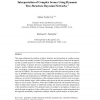Free Online Productivity Tools
i2Speak
i2Symbol
i2OCR
iTex2Img
iWeb2Print
iWeb2Shot
i2Type
iPdf2Split
iPdf2Merge
i2Bopomofo
i2Arabic
i2Style
i2Image
i2PDF
iLatex2Rtf
Sci2ools
CVIU
2007
2007
Interpretation of complex scenes using dynamic tree-structure Bayesian networks
This paper addresses the problem of object detection and recognition in complex scenes, where objects are partially occluded. The approach presented herein is based on the hypothesis that a careful analysis of visible object details at various scales is critical for recognition in such settings. In general, however, computational complexity becomes prohibitive when trying to analyze multiple sub-parts of multiple objects in an image. To alleviate this problem, we propose a generative-model framework – namely, dynamic tree-structure belief networks (DTSBNs). This framework formulates object detection and recognition as inference of DTSBN structure and image-class conditional distributions, given an image. The causal (Markovian) dependencies in DTSBNs allow for design of computationally efficient inference, as well as for interpretation of the estimated structure as follows: each root represents a whole distinct object, while children nodes down the sub-tree represent parts of that o...
| Added | 13 Dec 2010 |
| Updated | 13 Dec 2010 |
| Type | Journal |
| Year | 2007 |
| Where | CVIU |
| Authors | Sinisa Todorovic, Michael C. Nechyba |
Comments (0)

